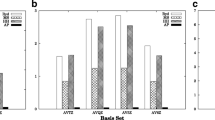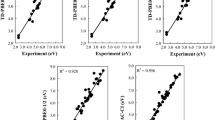Abstract
In this work, we propose new double-zeta atomic bases for the Li and Be atoms. These were obtained by applying the Hartree-Fock-Gauss generalized simulated annealing (GSA) method—a modified form of the GSA algorithm. The new bases were generated through optimization of the atomic electronic energy functional with regards to the linear combination of atomic orbitals-molecular orbital (LCAO-MO) coefficients, and exponent and contraction coefficients of the primitive Gaussian functions, simultaneously. These new bases were tested by performing calculations of the ground state energy of the Be atom, and the ground state energy and permanent electrical dipole moment of the LiH molecule, using the multi-reference Hartree-Fock (HF) configuration interaction method—a multi-reference method based on multiple HF solutions. In addition, multi-reference HF configuration interaction calculations were performed for the Be atom using the standard double-zeta, triple-zeta and polarized double-zeta bases. With the new double-zeta bases and with reduced multi-reference HF bases, it was possible to obtain lower energies than those obtained with the full configuration interaction calculations using the standard double-zeta bases and dipole moment values in close agreement with experimental values.
Similar content being viewed by others
Notes
In this work all calculations for the LiH molecule were performed using the new dz atomic base for the Li atom and the standard dz atomic base for the H atom.
The sets of LCAO-MO coefficients for the HF solutions can be obtained on request.
The MRHF bases employed in the MRHFCI calculations can be obtained on request.
References
de Andrade MD, Nascimento MAC, Mundim KC, Sobrinho AMC, Malbouisson LAC (2008) Atomic basis sets optimization using the generalized simulated annealing approach: new basis sets for the first row elements. Int J Quantum Chem 108:2486–2498. doi:10.1002/qua.21666
Tsallis C, Stariolo DA (1996) Generalized simulated annealing. Physica A 233:395–406. doi:10.1016/s0378-4371(96)00271-3
Malbouisson LAC, Martins MGR, Makiuchi N (2006) One-electron properties using a CI method based on multiple Hartree-Fock solutions. Int J Quantum Chem 106:2772–2778. doi:10.1002/qua.21035
Sobrinho AMC, Nascimento MAC, de Andrade MD, Malbouisson LAC (2008) Molecular one-electron properties using the multireference Hartree-Fock CI method. Int J Quantum Chem 108:2595–2602. doi:10.1002/qua.21672
Malbouisson LAC, de Andrade MD, Sobrinho AMC (2012) Quadrupole moment of the hydrogen fluoride using the multireference Hartree-Fock CI method. Int J Quantum Chem 112:3409–3413. doi:10.1002/qua.24272
Gorá RW, Zalesny R, Kozłowska J, Naciazek P, Roztoczynska A, Strasburger K, Bartkowiak W (2012) Electric dipole (hyper)polarizabilities of spatially confined LiH molecule. J Chem Phys 137:094307. doi:10.1063/1.4748144
Moret MA, Pascutti PG, Bisch PM, Mundim KC (1998) Stochastic molecular optimization using generalized simulated annealing. J Comput Chem 19:647–657. doi:10.1002/(sici)1096-987x(19980430)19:6<647::aid-jcc6>3.3.co;2-e
Moret MA, Bisch PM, Mundim KC, Pascutti PG (2002) New stochastic strategy to analyze helix folding. Biophys J 82:1123–1132. doi:10.1016/s0006-3495(02)75471-4
de Andrade MD, Mundim KC, Malbouisson LAC (2005) GSA algorithm applied to electronic structure: hartree-fock-GSA method. Int J Quantum Chem 103:493–499. doi:10.1002/qua.20580
de Andrade MD, Nascimento MAC, Mundim KC, Malbouisson LAC (2006) GSA algorithm applied to electronic structure II: UHF-GSA method. Int J Quantum Chem 106:2700–2705. doi:10.1002/qua.21080
Adams WH (1962) Stability of Hartree-Fock states. Phys Rev 127:1650–1658. doi:10.1103/physrev.127.1650
Stanton RE (1968) Multiple solutions to the Hartree-Fock problem. I. General treatment of two-electron closed-shell systems. J Chem Phys 48:257–262. doi:10.1063/1.1667913
Malbouisson LAC, Vianna JDM (1990) J Chim Phys Phys Chim Biol 87:2017
Barbosa AGH, Nascimento MAC (2002) Generalized multistructural method: theoretical foundations and applications. In: Cooper DL (ed) Valence bond theory. Elsevier, Amsterdam, pp 117–143. doi:10.1016/S1380-7323(02)80006-1
Bundgen P, Grein F, Thakkar AJJ (1995) Dipole and quadrupole moments of small molecules. An ab initio study using perturbatively corrected, multi-reference, configuration interaction wave functions. J Mol Struct THEOCHEM 334:7–13. doi:10.1016/0166-1280(94)03974-p
Palmieri P, Tarroni R, Mitrushenkov AO, Rettrup S (1998) Efficient truncation strategies for multi-reference configuration interaction molecular energies and properties. J Chem Phys 109:7085–7092. doi:10.1063/1.477391
Ayala PY, Schlegel HB (1998) A nonorthogonal CI treatment of symmetry breaking in sigma formyloxyl radical. J Chem Phys 108:7560–7567. doi:10.1063/1.476190
Dunning TH, Hay PJ (1977) Gaussian basis sets for molecular calculations. In: Shaefer HF III (ed) Methods of electronic structure theory. Springer New York, pp 1–27. doi:10.1007/978-1-4757-0887-5_1
Roothaan CCJ (1951) New developments in molecular orbital theory. Rev Mod Phys 23:69–89. doi:10.1103/revmodphys.23.69
Pople JA, Nesbet RK (1954) Self-consistent orbitals for radicals. J Chem Phys 22:571–572. doi:10.1063/1.1740120
Pulay P (1980) Convergence acceleration of iterative sequences. The case of SCF iteration. Chem Phys Lett 73:393–398. doi:10.1016/0009-2614(80)80396-4
Pulay P (1982) Improved SCF convergence acceleration. J Comput Chem 3:556–560. doi:10.1002/jcc.540030413
Kudin KN, Scuseria GE, Cancès E (2002) A black-box self-consistent field convergence algorithm: one step closer. J Chem Phys 116:8255–8261. doi:10.1063/1.1470195
Brown KM (1969) A quadratically convergent newton-like method based upon gaussian elimination. SIAM J Numer Anal 6:560–569. doi:10.1137/0706051
Rothstein E (1969) Molecular constants of lithium hydrides by the molecular-beam electric resonance method. J Chem Phys 5:1899–1900. doi:10.1063/1.1671294
Acknowledgments
The authors acknowledge Conselho Nacional de Desenvolvimento Científico e Tecnológico (CNPq) and Fundação de Amparo à Pesquisa do Estado do Rio de Janeiro (FAPERJ) for financial support.
Author information
Authors and Affiliations
Corresponding author
Additional information
This paper belongs to Topical Collection Brazilian Symposium of Theoretical Chemistry (SBQT2013)
Rights and permissions
About this article
Cite this article
de Cerqueira Sobrinho, A.M., de Andrade, M.D., Nascimento, M.A.C. et al. Multi-reference Hartree-Fock configuration interaction calculations of LiH and Be using a new double-zeta atomic base. J Mol Model 20, 2382 (2014). https://doi.org/10.1007/s00894-014-2382-6
Received:
Accepted:
Published:
DOI: https://doi.org/10.1007/s00894-014-2382-6




